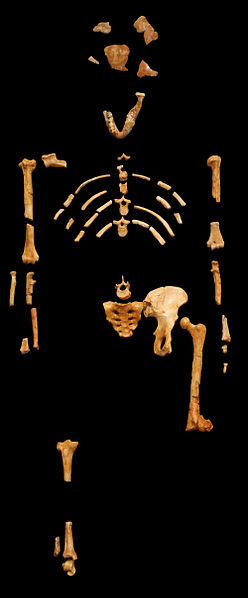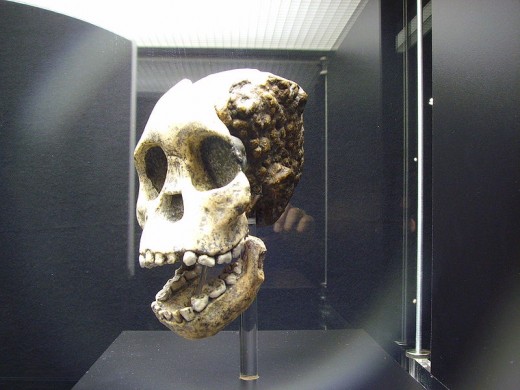Human Evolution: Australopithecus
An Evolutionary Giant

The Most Famous Skeleton In History

The Upright Ape
If somebody was to ask you what was the most significant moment in the entire history of humanity- which one would you choose? The discovery of electricity? The rise of religions? How about the invention of writing? Or, going even further back, the birth of spoken language itself? There is, in fact, a development more significant than any of these. It probably happened sometime between four and five million years ago and occurred within the primate family called the Great Apes. This transformative evolutionary adaptation originated in a species, ancestral to modern humans, who did simply this: it learned to walk on its own two feet.
The two biggest physiological differences between man and his closest genetic cousins, chimpanzees and bonobos, are that humans have bigger brains (roughly four times larger) and that humans walk on two feet, whereas chimps and bonobos have stayed on all fours.
The decision to swivel on to two feet is one of the most significant evolutionary milestones in what it means to be human. For a long time its impact was masked by a notorious scientific hoax. Piltdown Man was a collection of human skull fragments found near a village in Sussex, England between 1908 and 1915. These bones, it was claimed, dated back at least twenty million years. For decades they were seen by some as proof that man was not after all descended from apes but belonged to its own separate evolutionary line. More important to others was the idea that fossils found in Edwardian England showed clearly that imperial Britannia led the way in human progress.
After forty years of acceptance by most of the scientific community. Piltdown Man was finally revealed as a forgery in 1953 thanks to the research of Oxford anatomist Joseph Wiener. He showed conclusively that these bones were nothing more than the merged remains of a modern human and ape skull. The Piltdown perpetrators have never been revealed.
But the debacle, even after its exposure, left the lasting impression that in human evolution large brains evolved before the ability to walk upright. As a result it was thought that humans began to walk upright owing to their large capacity for mental thought. They did it because; they deduced that it was a good idea. However, recent fossil discoveries of the bones of bipedal apes have now provided incontrovertible proof that walking on two feet evolved long before big brains.
Australopithecus, an ape like creature that pioneered bipedalism, had a brain about the same size as that of a modern chimpanzee (about 400 millilitres). Therefore, it is far more likely that the innovation of learning to walk upright itself contributed towards the development of larger brains rather than vice versa.
Australopithecus lived in Africa between about 4.5 and 2.5 million years ago and, since its bones were first discovered by Raymond Dart in 1924, a wide range of skulls, skeletons and even footprints have been unearthed by palaeontologists. The most famous is a 40 per cent complete skeleton nicknamed Lucy, painstakingly uncovered in Ethiopia in 1974 by a team of palaeontologists led by American anthropologist Donald Johanson. The shape of the feet, pelvis and spine of this 3.2 million year old Australopithecus shows beyond all reasonable doubt that her kind walked upright. Volcanic footprints found in Kenya at Laetoli were most likely made by the same, or similar, species about 500,000 years before.
More On The Piltdown Man Debacle
- BBC NEWS
An overview of the Piltdown Man discovery and how it was uncovered as a hoax.
Uncovering The Origins Of Bipedalism
Two Interesting Links
- Aquatic ape hypothesis - Wikipedia, the free encyclopedia
An overview of an interesting theory relating to human origins. This theory is based around the idea that we acquired most of our strange characteristics through living a semi aquatic lifestyle early on in our history. - Lowly origin of bipedalism :: the squatting model | john hawks weblog
An overview of the squat feeding hypothesis for the origins of bipedalism orignally proposed by Jonathan Kingdon.
Two Very Interesting Books

The First African Fossil

Why Stand Upright In The First Place?
Why swivel on to two feet in the first place? Unfortunately, there is still no scientific agreement on that critical point. There are a number of competing theories. Clearly, there are certain advantages to a life on two feet, rather than four. Stretching up for food that would otherwise be out of reach is one. Looking out for danger in grassland areas where there are no trees is another. Wading through rivers is a third, since it is easier to ford deeper water by walking upright than on all fours.
Others think that the gorilla like ancestors of Australopithecus rose on to two feet, Tarzan-like, to ward off predators. It has even been suggested that their two footed antics could have been some sort of mating display by males who wished to impress females with the size of their manhood , while females rose up to protect their private parts from rearward attack. Some think walking on two feet began as a fashion- something ‘cool’ designed to impress females (or perhaps pioneered by females to impress males) that then caught on. Once some of the advantages of living on two legs rather than four kicked in, natural selection in favour of those with the best attributes for walking upright took over.
Perhaps the most significant advantage of walking on two feet is the one highlighted by Charles Darwin in his book on human origins, The Descent of Man, published in 1871. He observed that: ‘Man could not have attained his present dominant position in the world without the use of his hands, which are so admirably adapted to act in obedience to his will.’
By freeing their arms and hands from the task of walking they could then be used for other purposes such as fetching and carrying food for storage to help him survive severe weather conditions. When wading across streams their hands could grip rocks and trees for safety. Hands not designed for walking could become more dexterous and be deployed for making tools such as clubs and spears to kill fish and other animals for food.
Walking upright is therefore an evolutionary magic bullet, an adaptation that had a most profound impact on the planet, life and people. Its pioneering species was Australopithecus. Until recently it was thought that hand tools originated with the descendants of Australopithecus, a species called Homo habilis. Traditionally these species are classified as the first true hominids because their brains, at around 650 millilitres, were significantly larger than those of either modern chimpanzees or ancient Australopithecus. But in 1996 a research team led by Ethiopian palaeontologist Berhane Asfaw and American Tim White discovered primitive stone tools dating back 2.6 million years scattered next to the remains of a previously unknown Australopithecus species. They named it Australopithecus garhi, meaning ‘surprise’ in the local Ethiopian language.
The find suggests that Australopithecus gained major survival advantages as a result of walking upright and freeing its hands to make tools. What extraordinary evolutionary consequences lay in wait from this single adaptation! Like two legged dinosaurs hundreds of millions of years before, these bipedal mammals were soon well placed to dominate life on land. But, unlike the dinosaurs they did it not by brute strength, but by using their hands and with what was to follow, much larger brains.
By about 2.5 million years ago various species of Australopithecus, some slender omnivores, others more solidly built vegetarians, gave way to descendants such as Homo habilis, whose increasing skill at crafting tools made a vital contribution towards the evolution of more advanced hand eye coordination, better problem solving abilities and, ultimately, larger brains. Throwing weapons they had fashioned allowed them to hunt at a distance without endangering their own lives, ensuring that the genetic impetus of their two legged lineage, pioneered by Lucy and her ilk, powered ever on.








